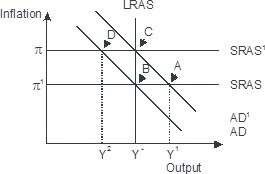In oligopoly, any action by one firm to change price, output, or quality causes
A) a reaction by other firms.
B) no reaction from the other firms.
C) a profit gain for the other firms.
D) loss of market share by the acting firm.
Answer: A
You might also like to view...
Based on the figure below. Starting from long-run equilibrium at point C, a tax increase that decreases aggregate demand from AD1 to AD will lead to a short-run equilibrium at point ________ and eventually to a long-run equilibrium at point ________, if left to self-correcting tendencies.
A. D; C B. D; B C. A; B D. B; C
The total number of people aged 16 years and over who are not institutionalized ________
A) equals the number of employed plus unemployed B) is the working-age population C) does not include students D) is the labor force
When calculating GDP, the Bureau of Economic Analysis revises its quarterly data
A) a total of one time. B) many times over the next several years. C) a total of three times. D) a total of two times.
What assumption does the Ricardian model of comparative advantage make in terms of converting resources?
What will be an ideal response?